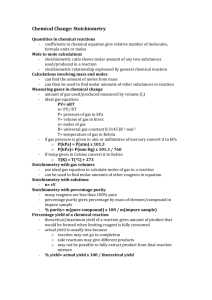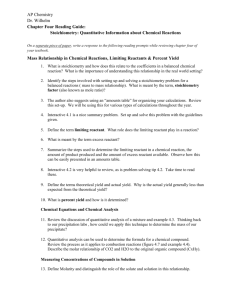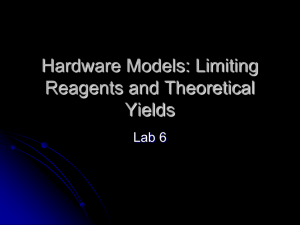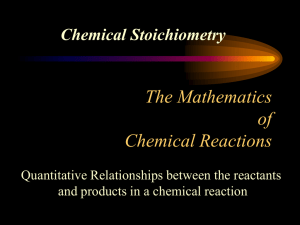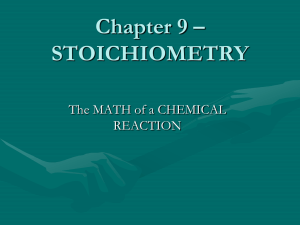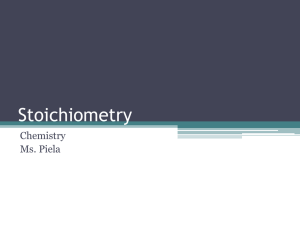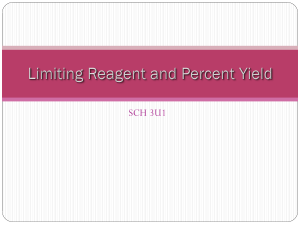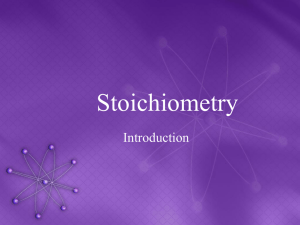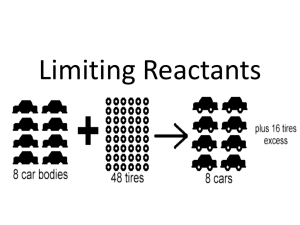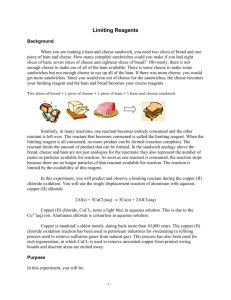Stoichiometry Powerpoint
advertisement
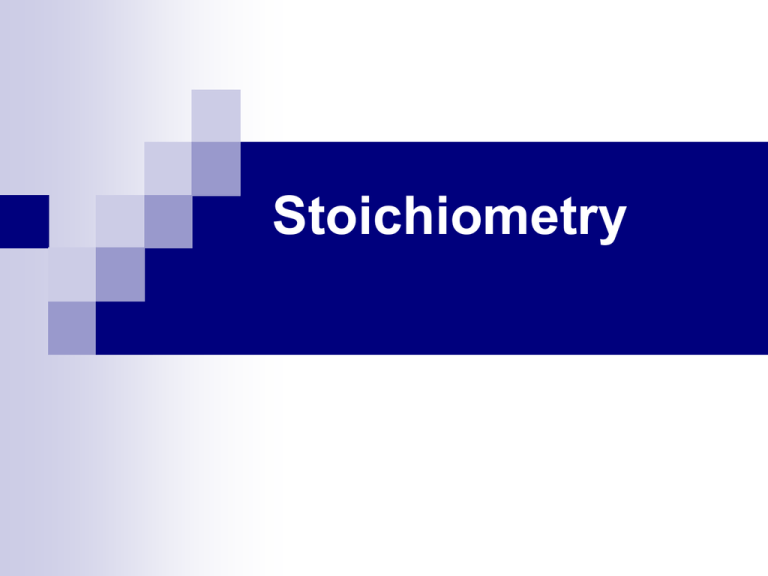
Stoichiometry TOPICS Everyday Stoichiometry Simple Stoichiometry Calculating Amount of Product or Reactant Limiting Reagent Percent Yield Standards Addressed: Conservation of Matter and Stoichiometry 3a. Students know how to describe chemical reactions by writing balanced chemical equations 3d. Students know how to determine the molar mass of a molecule from its chemical formula and a table of atomic masses an how to convert the mass of a molecular substance to moles, number of particles, or volume of gas at STP. 3e. Students know how to calculate the masses of reactants and products in a chemical reaction from the mass of one of the reactants or products and the relevant atomic masses. Definitions Stoichiometry: the study of mass relationships in chemical equations. Excess: more than enough available; won’t run out of that reactant Mole-mole ratio: how two substances are numerically related to each other in units of moles; you get these numbers from the balanced chemical equation. Everyday Stoichiometry: 2 wheels + 1 frame → 1 bike How many wheels and frames do you need to make 5 bikes? If you have 6 wheels and 4 frames, how many bikes can you make? If you have 11 wheels and 3 frames, how many bikes can you make? TOPICS Everyday Stoichiometry Simple Stoichiometry Calculating Amount of Product or Reactant Limiting Reagent Percent Yield Simple Stoichiometry: Here is the “recipe” for water: 2 H2 + O2 → 2 H2O *This recipe says: 2 molecules of H2 react with 1 molecule of O2 to produce 2 molecules of water 2 moles of H2 react with 1 mole of O2 to produce 2 moles of water *The balanced chemical equation gives us the “recipe” for how reactants combine to form products TOPICS Everyday Stoichiometry Simple Stoichiometry Calculating Amount of Product or Reactant Limiting Reagent Percent Yield Mole-Mole Ratios Come from the balanced chemical equation Ratio made between the “given” substance and the “get” substance Use the coefficients of the “given” and “get” from the balanced chemical equation Ratios can be between any 2 substances Reactant-reactant Reactant-product Product-product How do you know between which substances to make a mole-mole ratio? Mole-Mole Ratio Examples 2 H 2 + O 2 → 2 H 2O 2 mole H2 2 mole H2O 1 mole O2 2 mole H2 Mole-Mole Ratio Examples Fe2O3 (s) + 3 CO (g)→ 2 Fe (s) + 3 CO2 (g) Write a mol-mol ratio between the reactants… Write a mol-mol ratio between iron and carbon monoxide Write a mol-mol ratio between the products Calculating Amount of Reactant Needed 2 P + 3Cl2 → 2 PCl3 How many moles of phosphorus are consumed if 12 moles of phosphorus trichloride are produced? How Much Product is Produced? 2 P + 3Cl2 → 2 PCl3 How many moles of PCl3 can be formed from 5 moles chlorine and excess phosphorus? How many moles of chlorine are needed to react with 3.25 moles of phosphorus? Question 2 H2 + O2 → 2 H2O How many moles of water are produced by burning 2.72 mol H2 in an excess of O2? Question 2 H2 + O2 → 2 H2O How many moles of O2 are consumed in the complete combustion of 6.86g H2 ? Question 2 Ag2CO3 (s) → 4 Ag(s) + 2CO2(g) + O2(g) How many grams of Ag2CO3 must have decomposed if 75.1 grams of Ag were obtained in the reaction? Question 2 Ag2CO3 (s) → 4 Ag(s) + 2CO2(g) + O2(g) How many grams of carbon dioxide were produced if 25.0 g of oxygen were produced? Let’s Summarize the Steps 1. Is there a balanced chemical equation? 2. Write down the “given” and the “get” 3. Mini road map…g-mol-mol-g 4. Set-up a dimensional analysis equation 5. Cancel units and calculate 6. Report answer to correct # of sig. figs. THE LONGEST “MINI ROAD MAP” YOU WILL HAVE TO FOLLOW GRAMS----MOLES----MOLES----GRAMS Question KClO3 + 5 KCl + 6 HNO3 → 6KNO3 + 3Cl2 + 3 H2O How many grams of KClO3 are required to prepare 10.0g of Cl2 ? Iron (II) oxide decomposes into iron and oxygen gas. 2 FeO → 2 Fe + O2 How many grams of FeO are needed to produce 140.0 g of Fe? Hydrochloric acid reacts with zinc metal to produce zinc chloride and hydrogen gas 2 HCl + 2 Zn → ZnCl2 + H2 How many grams of hydrochloric acid are required to react completely with 1.00g of zinc? Topics Everyday Stoichiometry Simple Stoichiometry Calculating Amount of Product or Reactant Limiting Reagent Percent Yield Anticipatory Set 3 cups flour + 2 cups sugar + 1 cup butter + 3 eggs = 1 batch Flour 13 cups How many batches of cookies can we make? How did you Sugar 10 cups Butter 3 cups Eggs 20 figure it out? Flour-4 Sugar-5 Butter-3 Eggs-7, so we can only make 3 batches. The butter yields the smallest amount possible that can be produced. The butter tells how many bathes we can make; therefore the butter is the limiting ingredient. Summarize Here, we did multiple calculations side by side and then chose the correct result. We can use this same type of reasoning/procedure to calculate the limiting reagent in a given chemical reaction. Definition Limiting reagent: the reactant that is completely used up in the chemical reaction. The limiting reagent determines how much product can be formed. Calculating Limiting Reactant Which reactant will run out first? You can’t tell just by looking at it, so you need to do some calculations. NOTE: In limiting reagent problems, BOTH REACTANTS are converted to the same PRODUCT Calculating the Limiting Reagent P4 + 6 Cl2 → 4 PCl3 What mass of PCl3 forms in the rxn of 125g P4 with 323 g Cl2? Limiting Reagent CH4 + 2 O2 → CO2 + 2 H2O If 12.0g CH4 and 30.0g O2 react to form CO2 and H2O, how many grams of CO2 will be formed? Summarize the Steps we followed 1. Is there a balanced chemical equation? 2. Write down the 2 “givens” (reactants) and the “get” (the product) 3. Set-up Dimensional Analysis equations; 1 for each given g-mol-mol-g 4. Whichever reactant produced the smaller amount of product, that reactant is the limiting reagent 5. Make your concluding statement Topics Everyday Stoichiometry Simple Stoichiometry Calculating Amount of Product or Reactant Limiting Reagent Percent Yield Definitions Theoretical Yield: How much product you expect to get based on your calculation Actual Yield: Amount of product actually produced when the reaction is conducted… this amount is always stated in the problem Percent Yield: the percentage of theoretical yield obtained from the reaction Calculating Percent Yield % Yield = actual yield X 100 theoretical yield Calculating Percent Yield Determine the percent yield for the reaction between 98.7g of Sb2S3 and excess oxygen if 72.4 g of Sb4O6 are recovered along with an unknown amount of sulfur dioxide gas. Percent Yield Determine the percent yield for the reaction between 46.5 g of ZnS and excess oxygen if 18.4 g of ZnO are recovered along with an unknown amount of sulfur dioxide gas. 8.7 Enthalpy of a Reaction: A Measure of Heat Evolved or Absorbed in a Reaction Enthalpy: The amount of thermal energy emitted or absorbed by a chemical reaction, pressure is constant. Enthalpy of a Reaction (∆Hrxn): the amount of thermal energy (or heat) that flows when a reaction occurs at constant pressure. The sign of ∆H indicates the direction of heat flow. Negative Sign…heat flows out of the system into the surroundings…exothermic reaction Positive Sign… heat flows from the surroundings into the system …endothermic reaction Reaction Energy Diagrams Stoichiometry of ∆Hrxn Ratios can be made between the moles of a substance and the enthalpy of the reaction, ∆Hrxn g ↔ mol ↔ kJ Ex 8.7 An LP gas tank in a home BBQ contains 11.8 x 103 g of propane (C3H8). Calculate the heat in kJ associated with the complete combustion of all the propane in the tank. (-5.47 x 105 kJ) C3H8 (g) + 5 O2(g) → 3 CO2 (g) + 4 H2O (g) ∆Hrxn= -2044 kJ SB 8.7 Ammonia reacts with oxygen: 4 NH3 (g) + 5 O2(g) → 4 NO (g) + 6 H2O (g) ∆Hrxn= -906 kJ Calculate the heat in kJ associated with the complete reaction of 155 g NH3. (-2.06 x 103kJ) SB+ What mass of butane, in grams, is necessary to produce 1.5 x 103 kJ of heat? What mass of CO2 is produced? ( 33 g 99 g CO2) C4H10 + 13/2 O2 → 4 CO2 (g) + 5 H2O (g) ∆Hrxn= 2658 kJ C4H10 + 13/2 O2 → 4 CO2 (g) + 5 H2O (g) ∆Hrxn= -2658 kJ What mass of CO2 is produced? (99 g CO2) END

